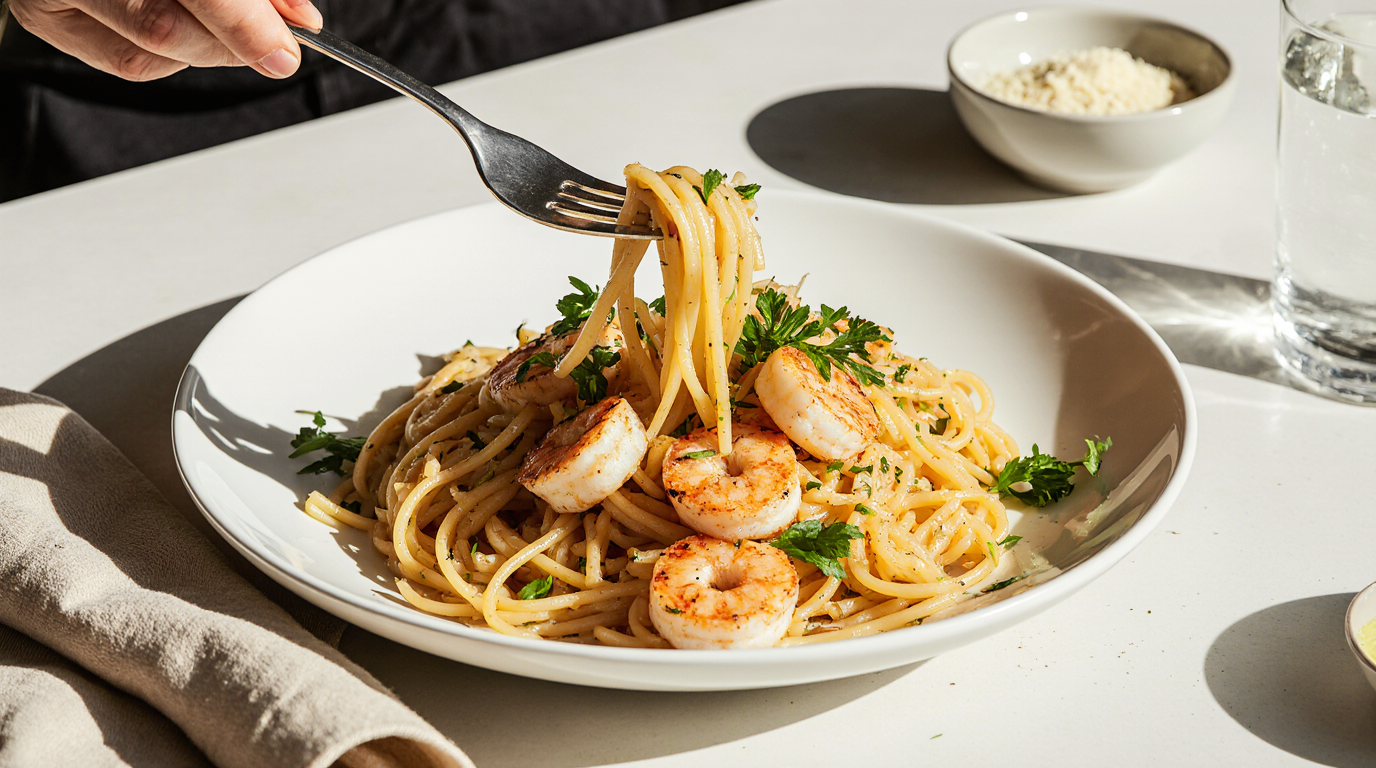Shrimp and Linguine Recipe – Simple, Elegant & Full of Flavor
Imagine savoring a dish that’s both elegant and easy to prepare. You’re about to discover how to create a restaurant-quality shrimp scampi linguine in the comfort of your own kitchen. This classic Italian-American dish is a staple for a reason – it combines the freshness of succulent shrimp with the rich flavors of garlic, herbs, and a hint of lemon, all perfectly balanced on a bed of tender linguine.
Preparing this shrimp and linguine recipe is surprisingly straightforward, requiring just a few ingredients and some simple cooking techniques. Whether you’re looking to impress dinner guests or simply craving a delicious meal, this recipe is sure to satisfy. With its flavorful sauce and delicate pasta, it’s a dish that’s sure to become a favorite.
Key Takeaways
- Learn how to make a simple yet elegant shrimp scampi linguine dish.
- Discover the essential ingredients and cooking techniques required.
- Understand how to balance flavors for a restaurant-quality meal.
- Impress your dinner guests with this classic Italian-American recipe.
- Enjoy a delicious and satisfying meal with minimal preparation.
The Allure of Shrimp and Linguine – A Perfect Pairing
The union of succulent shrimp and delicate linguine pasta is a match made in culinary heaven, offering a dish that’s both refined and easy to prepare. You might wonder what makes this pairing so special. The answer lies in the harmony between the tender, flavorful shrimp and the light, delicate pasta.
Shrimp scampi pasta has become a staple in many kitchens due to its simplicity and the elegance it brings to the dining table. The dish’s versatility is another reason for its enduring popularity; it can be served as a quick weeknight meal or as the centerpiece for a more formal dinner party.
One of the key reasons you love shrimp and linguine is the way the flavors meld together. The garlic butter sauce, a crucial component of a best shrimp scampi pasta recipe, coats the linguine, infusing each bite with a rich, savory taste. Meanwhile, the shrimp add a sweetness and texture that complements the pasta perfectly.
- The delicate flavor of linguine doesn’t overpower the shrimp.
- The shrimp’s succulence is enhanced by the garlic butter sauce.
- This dish is highly adaptable, allowing for variations that suit different tastes.
As you explore the world of shrimp and linguine, you’ll find that its appeal lies not just in its taste, but also in its ability to bring people together. Whether you’re cooking for a special occasion or a casual dinner, this classic combination is sure to impress.
Understanding the Origins of Shrimp Scampi Linguine
Tracing the history of Shrimp Scampi Linguine reveals a fascinating story of culinary adaptation and innovation. This dish, which has become a staple in many Italian-American households, has its roots in traditional Italian cuisine.
Italian-American Roots of the Dish
Shrimp Scampi Linguine is a quintessential Italian-American dish that originated from the Italian tradition of cooking shrimp with garlic, known as “scampi.” Italian immigrants brought their culinary practices to America, where they adapted to local ingredients and tastes. The result was a simplified yet flavorful version of the original Italian recipes.
Evolution of Shrimp Scampi Through the Years
Over time, Shrimp Scampi Linguine has undergone significant changes, influenced by various cultural and culinary trends. The original scampi dish, which used a type of small crustacean, was adapted to use shrimp, a more readily available ingredient in the United States. The addition of linguine pasta, a staple in Italian cuisine, created a harmonious and satisfying meal that has remained popular to this day.
As you explore the world of Shrimp Scampi Linguine, you’ll discover that its evolution is a testament to the dynamic nature of culinary traditions. By understanding its origins, you can better appreciate the simplicity and elegance of this beloved dish.
Essential Ingredients for the Perfect Shrimp and Linguine Recipe
Creating an exceptional shrimp and linguine dish starts with selecting the finest ingredients. The quality of your shrimp, pasta, and aromatics will directly impact the flavor and overall enjoyment of your meal.
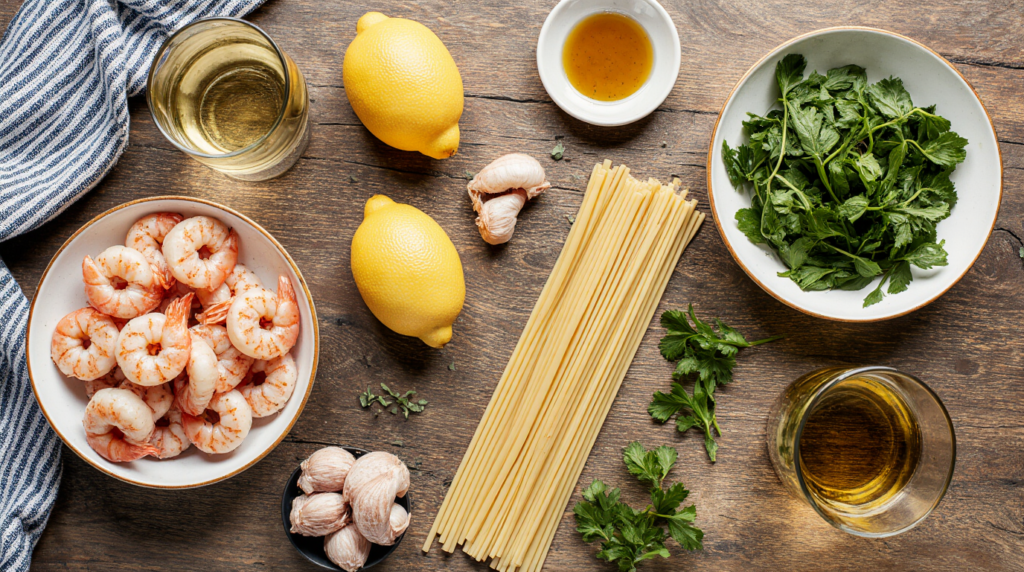
Selecting the Best Shrimp for Your Dish
When it comes to choosing shrimp for your shrimp and linguine recipe, freshness is paramount. Look for shrimp that are firm to the touch, have a mild smell, and are free of visible damage. You can choose between wild-caught or farmed shrimp, with wild-caught often having a more robust flavor. For the best shrimp scampi pasta recipe, opt for large or extra-large shrimp as they provide a better texture and presentation.
| Shrimp Type | Characteristics | Best For |
|---|---|---|
| Wild-Caught | Robust flavor, firmer texture | Shrimp Scampi Linguine |
| Farmed | Milder flavor, softer texture | Quick Shrimp and Linguine Recipes |
Choosing Quality Linguine Pasta
The type of linguine pasta you choose can significantly affect your dish. Opt for high-quality, Italian-made linguine for the best flavor and texture. Look for pasta made from durum semolina flour, as it holds its shape well during cooking and provides a satisfying bite. Avoid linguine with additives or coloring that might alter the dish’s overall taste.
Fresh vs. Dried Herbs and Aromatics
The choice between fresh and dried herbs can make a significant difference in your shrimp and linguine recipe. Fresh herbs like parsley, garlic, and lemon provide a bright, vibrant flavor. However, dried herbs can be just as effective, especially when fresh is not available. For aromatics like garlic, using a combination of both fresh and roasted can add depth to your best shrimp scampi pasta recipe.
By focusing on these essential ingredients, you’ll be well on your way to creating a shrimp and linguine dish that’s both elegant and full of flavor.
Kitchen Equipment You’ll Need
To get started with your shrimp and linguine recipe, you’ll need to gather a few key kitchen essentials. Having the right equipment on hand will make the cooking process smoother and more enjoyable.
Essential Pots and Pans
A large pot is necessary for boiling your linguine pasta. You’ll want a pot that’s big enough to hold the pasta and plenty of water. A deep skillet or sauté pan is also essential for cooking your shrimp and creating the scampi sauce. Look for a pan that’s large enough to hold all your ingredients comfortably.
Helpful Utensils and Tools
In addition to the right pots and pans, you’ll need some basic utensils to prepare your shrimp scampi pasta. A chef’s knife is crucial for chopping garlic and herbs, while a colander is necessary for draining your cooked linguine. You’ll also want to have a wooden spoon or silicone spatula on hand for stirring your sauce and combining your ingredients.
Preparing Your Ingredients – Mise en Place
Mise en place is a French culinary term that means having all your ingredients ready to cook, which is crucial for making a great shrimp and linguine recipe. This step is essential for a smooth cooking process and ensures that your dish turns out perfectly. By having all your ingredients prepped and ready, you’ll be able to focus on cooking your shrimp scampi linguine to perfection.
Cleaning and Deveining Shrimp
The first step in preparing your shrimp is to clean and devein them. To do this, start by rinsing the shrimp under cold water to remove any impurities. Then, use a sharp knife or a specialized deveining tool to remove the dark vein that runs along the back of the shrimp. This vein can be gritty and detract from the overall texture of your dish. After deveining, pat the shrimp dry with paper towels to remove excess moisture.
| Shrimp Preparation Step | Description |
|---|---|
| Rinsing | Rinse shrimp under cold water to remove impurities. |
| Deveining | Remove the dark vein along the back of the shrimp. |
| Drying | Pat the shrimp dry with paper towels. |
Prepping Garlic, Herbs, and Other Aromatics
Next, you’ll need to prepare your garlic, herbs, and other aromatics. Start by peeling and mincing the garlic. You can use a garlic press or a microplane grater to get the job done. For herbs like parsley, simply chop them finely with a sharp knife. Other aromatics like lemon zest can be grated using a zester or fine grater. Having these ingredients prepped and ready will make it easier to cook your shrimp scampi linguine to perfection.
- Peel and mince garlic.
- Chop fresh herbs like parsley.
- Grate lemon zest using a zester or fine grater.
Classic Shrimp and Linguine Recipe – Step by Step
Now that we have our ingredients ready, it’s time to dive into the classic shrimp and linguine recipe. This dish is a staple of Italian-American cuisine, known for its simplicity and rich flavors. By following these steps, you’ll be able to create a restaurant-quality meal in the comfort of your own home.
Cooking the Perfect Al Dente Linguine
Cooking linguine al dente is crucial for the overall texture of the dish. To achieve this, bring a large pot of salted water to a boil. The general rule is to use about 1 tablespoon of salt for every 4 cups of water. Once boiling, add your linguine and cook according to the package instructions until it’s al dente. Reserve 1 cup of pasta water before draining the linguine.
Using a large pot ensures that the linguine cooks evenly. It’s also important to stir the pasta occasionally as it cooks to prevent it from sticking together.
Sautéing Shrimp to Perfection
Sautéing shrimp requires quick cooking over high heat to preserve their tender texture. Start by heating a skillet over medium-high heat and add a tablespoon of olive oil. Once the oil is hot, add the shrimp in a single layer, being careful not to overcrowd the pan. Cook for about 2 minutes on each side, or until they turn pink and are cooked through.
It’s essential to not overcook the shrimp, as they can become rubbery. Remove them from the heat as soon as they’re done.
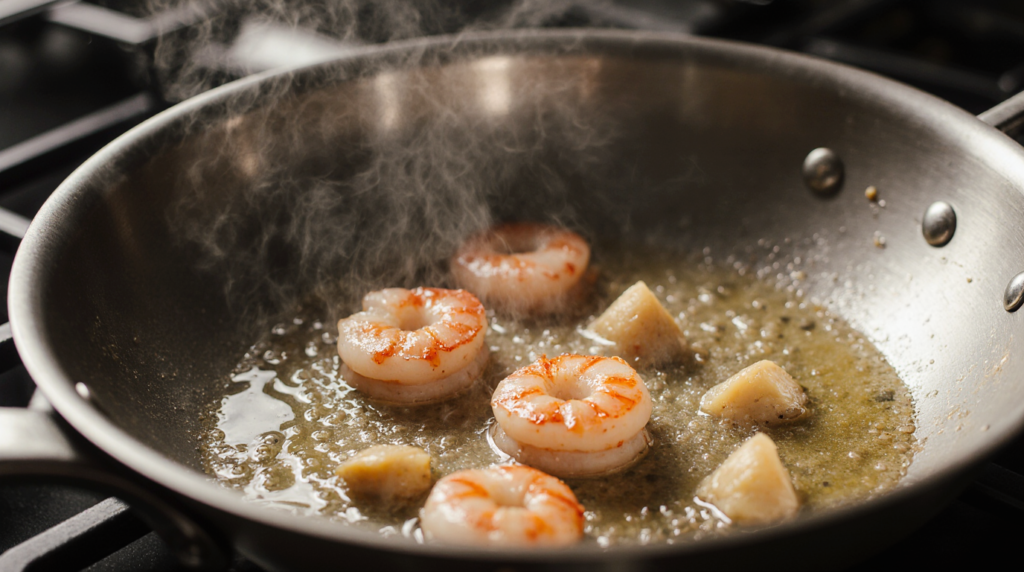
Creating a Flavorful Sauce
The sauce is where the flavors of the dish come together. In the same skillet used for the shrimp, add minced garlic and cook until fragrant. Then, add white wine (or chicken broth as an alternative) to deglaze the pan, scraping up any browned bits from the bottom. Allow the liquid to reduce by half, then add in some freshly squeezed lemon juice and chopped parsley.
The acidity from the lemon juice helps to brighten the flavors of the dish, while the parsley adds freshness.
Combining All Elements of the Dish
To finish the dish, combine the cooked linguine, sautéed shrimp, and the flavorful sauce. Toss everything together, ensuring the linguine is well coated with the sauce. If the sauce seems too thick, you can add a bit of the reserved pasta water to achieve the desired consistency.
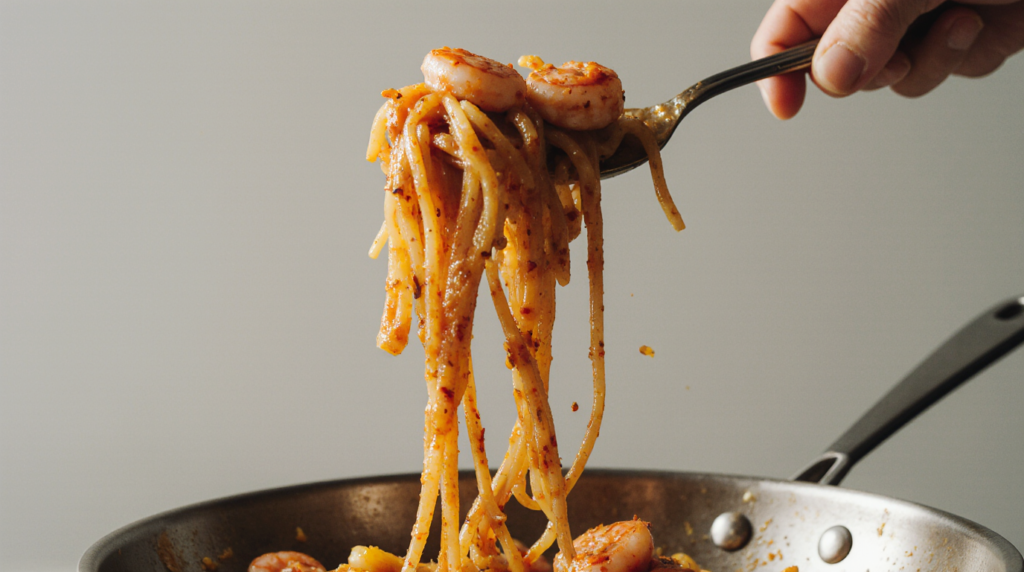
Serve immediately, garnished with additional parsley if desired. The combination of tender shrimp, al dente linguine, and a rich, garlicky sauce is sure to impress.
Delicious Variations of Shrimp Scampi Linguine
The beauty of shrimp scampi linguine lies in its adaptability, allowing you to experiment with numerous flavors and ingredients. This classic Italian-American dish can be transformed in various ways to suit your taste preferences. Whether you’re in the mood for something creamy, spicy, or infused with citrus, there’s a variation of shrimp scampi linguine to satisfy your cravings.
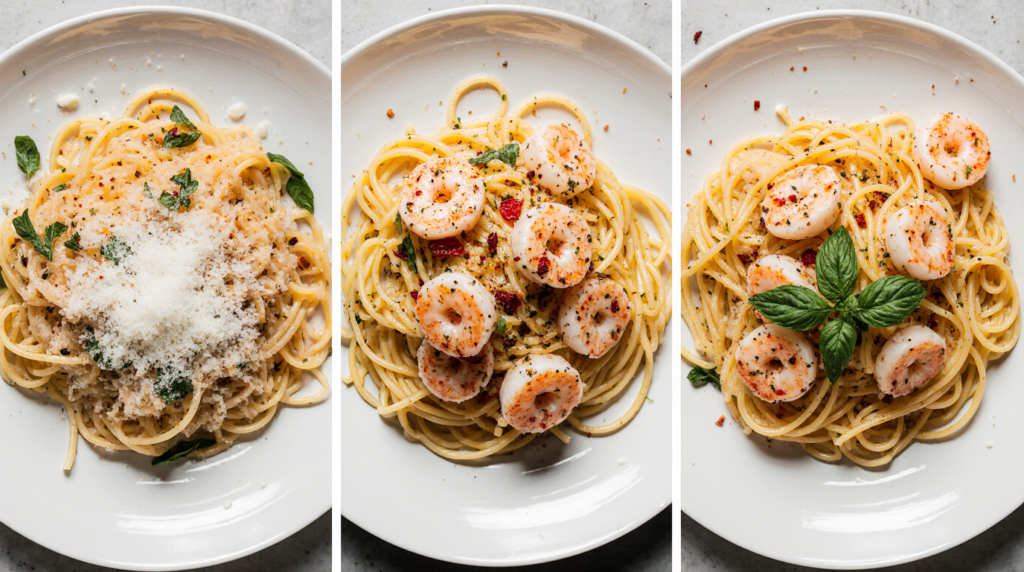
Creamy Shrimp Scampi Linguine
Adding a creamy element to shrimp scampi linguine can enrich its flavor profile. You can achieve this by incorporating heavy cream or half-and-half into the sauce, along with some grated Parmesan cheese. This creamy version is perfect for those who prefer a richer, more indulgent pasta dish.
- Start by sautéing the shrimp as you would in the classic recipe.
- Add a splash of heavy cream towards the end of cooking the garlic and herbs.
- Stir in Parmesan cheese until melted and well combined.
Spicy Shrimp and Linguine
For those who enjoy a bit of heat, a spicy version of shrimp scampi linguine can be a thrilling twist. Introduce some red pepper flakes or sliced jalapeños into the sauce for an added kick. This variation is ideal for spice lovers looking to elevate their pasta game.
To make this spicy version, simply add your preferred spicy ingredient during the sautéing process, allowing the flavors to meld together beautifully.
Lemon Garlic Shrimp Linguine
Enhancing the citrus element in shrimp scampi linguine can result in a refreshing and zesty dish. By amplifying the lemon flavor, you can create a brighter, more vibrant version of the classic. This is perfect for spring or summer when citrus flavors are particularly appealing.
To make this variation, increase the amount of lemon juice and zest used in the recipe. You can also add some lemon slices to the pasta for added flavor and a pop of color.
White Wine Shrimp Scampi
Incorporating white wine into your shrimp scampi linguine can add depth and a sophisticated touch to the dish. The wine helps to deglaze the pan, capturing all the flavorful browned bits from cooking the shrimp and garlic. This variation is great for a more refined, restaurant-style shrimp scampi.
To incorporate white wine, add a small amount after sautéing the shrimp and garlic, then simmer until the liquid is almost completely reduced, intensifying the flavors.
How to Cook Scampi Shrimp for Maximum Flavor
Scampi shrimp, when cooked correctly, can transform a simple linguine recipe into a gourmet experience. The art of cooking scampi shrimp lies in understanding the delicate balance between flavor enhancement and texture preservation.
Proper Cooking Temperatures
Cooking scampi shrimp at the right temperature is crucial. The ideal temperature for cooking shrimp is between 120°F to 130°F (49°C to 54°C). At this range, shrimp cook quickly and retain their tender texture. Using a thermometer can help you achieve this precise temperature control.
Timing Techniques for Tender Shrimp
The timing of cooking shrimp is as important as the temperature. Generally, shrimp take about 2-3 minutes per side to cook. It’s essential to monitor the color and texture; shrimp are done when they turn pink and firm to the touch. Overcooking can make them rubbery, so timing is key.
Avoiding Overcooked, Rubbery Shrimp
To avoid overcooking, remove the shrimp from heat as soon as they’re done. It’s also helpful to shock them in an ice bath to stop the cooking process immediately. This technique ensures that your shrimp remain tender and juicy, enhancing the overall quality of your shrimp and linguine recipe.
| Cooking Method | Cooking Time | Result |
|---|---|---|
| Sautéing | 2-3 minutes per side | Tender and juicy |
| Grilling | 2-3 minutes per side | Smoky flavor, tender |
| Poaching | 5-7 minutes | Delicate flavor, tender |
By mastering the techniques of cooking scampi shrimp, you can elevate your shrimp and linguine recipe to a dish that’s both flavorful and visually appealing. Whether you’re sautéing, grilling, or poaching, the key is to cook with precision and attention to detail.
The Best Shrimp and Linguine Recipe for Special Occasions
For special occasions, a simple shrimp and linguine recipe can be transformed into a gourmet meal with a few key adjustments. Whether you’re celebrating a milestone or hosting a dinner party, this dish is sure to impress. The key to elevating your shrimp and linguine lies in the quality of your ingredients and the presentation.
Elevated Ingredients for Gourmet Results
To take your shrimp and linguine to the next level, consider using high-quality, fresh ingredients. This includes:
- Fresh, sustainably sourced shrimp
- Artisanal linguine pasta
- Freshly harvested garlic and herbs
- High-quality olive oil
- Grated Parmesan cheese
Using these ingredients not only enhances the flavor but also the overall dining experience. For instance, fresh shrimp will have a sweeter taste and firmer texture compared to frozen alternatives.
Presentation Techniques for Impressive Serving
The presentation of your dish can significantly impact the overall impression it makes. Here are some presentation techniques to consider:
- Arrange the linguine neatly on the plate.
- Top with succulent shrimp.
- Garnish with fresh parsley or basil.
- Drizzle with extra virgin olive oil.
- Sprinkle with Parmesan cheese.
A well-presented dish not only looks appealing but also shows the care you’ve put into preparing the meal.
Make-Ahead Tips for Stress-Free Entertaining
To reduce stress when entertaining, consider these make-ahead tips:
- Cook the linguine just before serving, but have it ready to go.
- Prepare the sauce and refrigerate it overnight.
- Marinate the shrimp ahead of time for enhanced flavor.
- Have all ingredients ready and within reach.
By preparing certain elements ahead of time, you can enjoy your gathering without the added stress of last-minute cooking.
Ingredient Substitutions and Adaptations
Whether you’re dealing with dietary restrictions or simply want to mix things up, knowing your options for ingredient substitutions can elevate your shrimp scampi experience. The versatility of shrimp and linguine recipe allows for various adaptations, ensuring that everyone can enjoy this classic dish.
Seafood Alternatives to Shrimp
If you’re not a fan of shrimp or need to accommodate other seafood preferences, there are several alternatives you can consider. Scallops, for instance, work beautifully with garlic butter and linguine, offering a similar tender texture. Crab meat is another excellent option, adding a rich flavor to the dish. For those who prefer a different flavor profile, fish like cod or halibut can be used, adjusting cooking times accordingly.
Pasta Options Beyond Linguine
While linguine is a traditional choice for shrimp scampi, it’s not the only pasta option available. Fettuccine, with its flat noodles, pairs well with the light, oily sauce. Spaghetti is another popular alternative, offering a slightly different texture. For a more rustic feel, pappardelle or even linguine’s close cousin, fettuccine, can be used, providing a hearty base for the seafood.
Dairy-Free and Gluten-Free Modifications
For those with dietary restrictions, there are several modifications that can be made. To make a dairy-free version, substitute butter with a vegan alternative and be mindful of the cheese used. Gluten-free pasta is widely available, made from rice, quinoa, or corn, making it easy to accommodate gluten-free dietary needs without sacrificing flavor.
Pairing Your Shrimp and Linguine with the Perfect Wine
The perfect glass of wine can complement the delicate flavors of shrimp scampi linguine. When you’re preparing this dish, choosing the right wine to pair with it can enhance your dining experience. Whether you’re looking for a classic combination or something a bit different, there are several options to consider.
White Wine Recommendations
For shrimp scampi linguine, a crisp and refreshing white wine is often the best choice. Pinot Grigio and Sauvignon Blanc are excellent options as they complement the dish’s citrus and herbal notes. If you prefer a richer white wine, a Chardonnay with moderate oak aging can also pair nicely, especially if your scampi has a creamy element.
Alternative Beverage Pairings
If you prefer not to drink wine or want an alternative, there are other beverages that can pair well with shrimp and linguine. A citrus-infused sparkling water can cleanse your palate between bites. For those who enjoy beer, a light Pilsner or Wheat Beer can complement the dish without overpowering it. Additionally, a refreshing iced tea with lemon or a fresh limeade can be a delightful alternative for a more casual dining experience.
Common Mistakes to Avoid When Making Shrimp Scampi Pasta
Achieving a flawless shrimp scampi pasta dish requires knowledge of the frequent mistakes cooks make and how to avoid them. Even with a simple recipe, there are several pitfalls that can compromise the quality of your shrimp scampi pasta.
Pasta Pitfalls
One of the most common mistakes is overcooking the linguine. To avoid this, cook your pasta al dente, as it will continue to cook slightly after draining. Another mistake is not salting the pasta water adequately, which can result in a bland dish.
Using low-quality pasta can also negatively impact your shrimp scampi. Opt for high-quality, fresh linguine to ensure the best flavor and texture.
Shrimp Cooking Errors
Overcooking the shrimp is a frequent error that can make them tough and rubbery. Cook shrimp just until they turn pink and are no longer translucent. Another mistake is not deveining the shrimp properly, which can leave a gritty texture.
Not patting the shrimp dry before cooking can also lead to steaming instead of searing, affecting the overall texture of the dish.
Sauce Troubleshooting
A common issue with shrimp scampi sauce is it becoming too oily or separating. To prevent this, ensure that you’re using high-quality ingredients and not overheating the sauce. Another tip is to add the butter gradually, whisking continuously to emulsify the sauce.
Not balancing the flavors can also result in a subpar sauce. Make sure to taste and adjust the seasoning as needed to achieve a harmonious balance of garlic, lemon, and herbs.
Nutritional Information and Dietary Adaptations
Understanding the nutritional value of your shrimp and linguine recipe is crucial for making informed dietary choices. This classic dish, while delicious, contains a mix of macronutrients and calories that can impact your overall diet.
Calorie and Macronutrient Breakdown
A typical serving of shrimp scampi linguine includes linguine pasta, shrimp, garlic, and often white wine or butter, contributing to its calorie count. On average, a serving can range from 400 to 600 calories, with a significant portion coming from the pasta and the sauce. The dish is also a source of protein from the shrimp, carbohydrates from the linguine, and fats from the butter or oil used in preparation. Understanding these components can help you balance your meal.
Lighter Versions of the Classic Recipe
To make a lighter version of shrimp and linguine, consider adjustments such as using whole wheat linguine instead of traditional white pasta, reducing the amount of butter or oil, and incorporating more vegetables. You can also opt for less shrimp and more vegetables to lower the calorie count while maintaining flavor. Additionally, using herbs and lemon juice can enhance flavor without adding extra calories. These modifications allow you to enjoy your favorite shrimp scampi linguine while keeping your dietary goals in check.
Storing and Reheating Your Shrimp and Linguine
Leftover shrimp and linguine can be just as enjoyable as when first cooked, provided you store and reheat it correctly. Proper handling ensures that the dish remains safe to eat and retains its flavor and texture.
Proper Storage Methods
To store leftover shrimp and linguine, cool it down quickly and refrigerate it within two hours. Use an airtight container to prevent moisture from affecting the pasta’s texture. You can store it in the refrigerator for up to 3 days. For longer storage, consider freezing, where it can last up to 3 months. When freezing, it’s best to store the shrimp and linguine in separate containers to preserve their individual textures.
Best Practices for Reheating Seafood Pasta
When reheating, gently warm the linguine over low heat, adding a splash of water or broth if it seems dry. For the shrimp, a quick sauté in a pan with a bit of oil or butter can revive its flavor. Alternatively, you can reheat the entire dish in the microwave, covered, on a lower power setting, stirring every 30 seconds until heated through. Be cautious not to overcook the shrimp during reheating.
Conclusion: Mastering the Art of Shrimp and Linguine
Now that you’ve explored the world of shrimp and linguine, it’s time to put your newfound knowledge into practice. With a simple shrimp and linguine recipe, you can create a delicious, restaurant-quality meal in the comfort of your own home. The best shrimp scampi pasta recipe is all about balance – tender shrimp, perfectly cooked linguine, and a flavorful sauce.
To achieve this balance, remember to select the freshest ingredients, cook your linguine al dente, and sauté your shrimp to perfection. Don’t be afraid to experiment with variations, such as adding a squeeze of fresh lemon juice or a sprinkle of parsley, to make the dish your own.
With practice, you’ll become a master of the shrimp and linguine recipe, impressing friends and family with your culinary skills. So, get cooking and enjoy the delightful flavors of this classic Italian-American dish.
FAQ
What is shrimp scampi pasta?
Shrimp scampi pasta is a classic Italian-American dish made with sautéed shrimp, garlic, and herbs, typically served with linguine.
How do I cook scampi shrimp?
To cook scampi shrimp, sauté them in a hot pan with garlic, butter, and herbs until they’re pink and tender, being careful not to overcook.
What is the best type of pasta for shrimp scampi?
Linguine is the traditional and best pasta choice for shrimp scampi due to its light, delicate texture and ability to hold onto the flavorful sauce.
Can I use frozen shrimp for shrimp scampi?
Yes, you can use frozen shrimp for shrimp scampi, but make sure to thaw them properly and pat dry before cooking to achieve the best results.
How do I prevent overcooking shrimp in scampi?
To prevent overcooking, cook shrimp just until they turn pink and are slightly firm to the touch, then immediately remove from heat.
What are some variations of shrimp scampi linguine?
Variations include adding cream for a creamy version, incorporating red pepper flakes for a spicy kick, or using different herbs and aromatics for unique flavors.
Can I make shrimp scampi linguine ahead of time?
While best served fresh, you can prepare components ahead of time, such as cooking linguine and prepping garlic and herbs, to streamline cooking.
What wine pairs well with shrimp scampi linguine?
A dry white wine, such as Pinot Grigio or Sauvignon Blanc, pairs well with shrimp scampi linguine, complementing its bright, citrusy flavors.
Is shrimp scampi linguine gluten-free?
Traditionally, shrimp scampi linguine is not gluten-free due to the pasta, but you can adapt it by using gluten-free linguine.
How do I store leftover shrimp scampi linguine?
Store leftovers in an airtight container in the refrigerator, and reheat gently to maintain the dish’s quality and safety.
Leave a Review & Rate This Recipe!
There are no reviews yet. Be the first one to write one.

